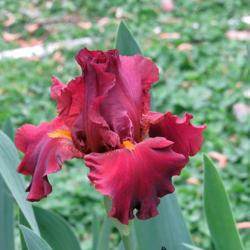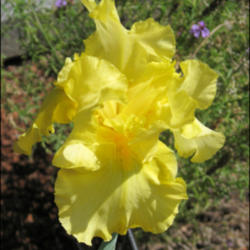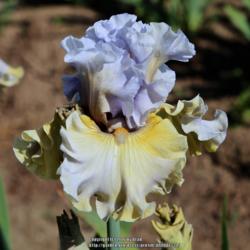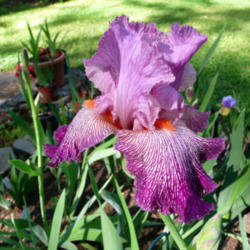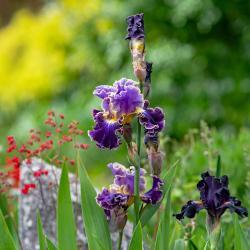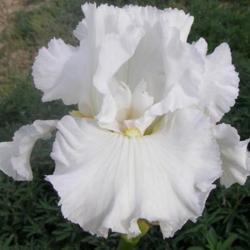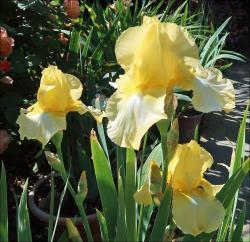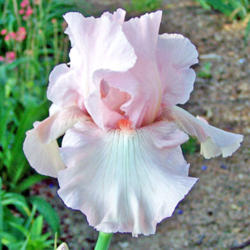Interesting topic!

I am still too new to the iris world to have a grasp on what is considered "good" form versus "bad". I am developing likes/preferences as I try things out, and acquire new irises in line with those preferences. It seems that I don't like flaring falls, or overly ruffled irises, for starters. I also want some proportion in the plant. TBs should be tall (28-33" imo is way too short). The standards should have a decent height relative to the falls. The overall bloom size should be in proportion to the stalk height (no small blooms atop 40" stalks).
As for color, I absolutely
want CLARITY in my bloom color, or at least not frank mud. I come from the daylily world, and I have seen bloom color run the gamut there from horrible mud to (rarely) clarity so pristine as to be almost unreal. (Unfortunately, in the latter case, that clarity often if not usually comes at the cost of too thin tissue which doesn't hold up through the day.) Most daylilies are somewhere in between, with some greater or lesser degree of "mud". With yellows it is generally not that noticeable; with other colors, it is. But it has been my experience that most people do not see the mud, until and unless they experience one of the cultivars with high clarity of color. Once you've seen clarity in a bloom, mud becomes easy to discern.
All of this is a way of saying that my experience of color in the daylily world affects how I see iris color. In that vein, I see most "red" and many (if not most or all) "orange" irises as being muddy. LEST WE FORGET is an award (H.M. 2012) winning, highly popular iris, has attractive color
from a distance, is seemingly a reliable rebloomer (in my garden), and has decent form (for a rebloomer) to boot. Yet I kicked it out of the garden because I simply could not stand the muddy color one more year.

The virtues of the plant could not (for me) compensate for the bad color.
I have a few other "red" and orange irises... the "red"s are the worst for mud, but I still have a very few which I hope to work with down the road. Ditto a couple of yellow rebloomers which (to me) have muddy color... I hope to work with those to get cleaner yellow rebloomers. AGAIN AND AGAIN is a reliable rebloomer here, but I dislike the color; it looks muddy to me. LUMINOSITY is not a reliable rebloomer, but it has very good color. I want the best of both worlds there.
All of that being said... you can't always get what you want. In the garden as in other aspects of life, sometimes compromises have to be made, and I guess this is where the topic of "new" color (or color blends, or color combinations/patterns/what-have-you) comes in.
For starters, there are those irises which are a greyed version of some hue or other. I'm still not entirely sure how I feel about those, if that grey dullness is equivalent to mud or not. (Maybe it is a lesser offense?

) I could see them working if either isolated (from other irises) by themselves, or else placed in combination with their more saturated color iris counterparts, so I have not yet thrown any of those out. HAUNTED HEART and one of its offspring FRIENDLY ADVICE are examples here.
In a similar vein (pun), I also have MOSBY'S GHOST. It lacks the veining of HAUNTED HEART and its offspring, but it is also an overall greyed bloom. I think it is subtly beautiful (maybe more so than HH etc. because of the lack of veining) and would do well with similar treatment (isolation or carefully selected companions).
Color combinations covers a lot of territory. Sometimes even if a new combination or blend is not as pristine in color as you would desire, so long as that mud isn't too bad, the overall garden effect can still be beautiful, especially if the iris is paired with the right partners. For example, I think that SERGEY has a beautiful bloom, but I simultaneously see that (at least in the falls) there is some degree of mud, because of the yellow/blue combination. But overall, to me it has a subtle beauty, perhaps because I accidentally had it paired with a saturated purple and a light blue self (TITAN'S GLORY and ABSOLUTE TREASURE, sorry, no combo pic), which really bring out the blue in SERGEY.
Sometimes, though, there is simply no hope for an iris, color wise. I had PRICELESS MEMORIES (direct from the hybridizer so I knew it was the correct plant), and I couldn't get rid of that iris quickly enough once it had bloomed. To me, the color was hopelessly muddy (at least in the standards, although I did not care for the falls as well), there were no companion irises which could ameliorate that, and thus there was no reason to keep it. (Yet it won an H.M. in 2019!!!

)
